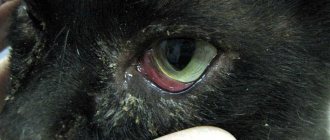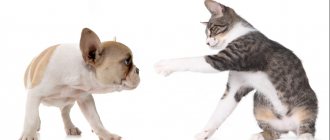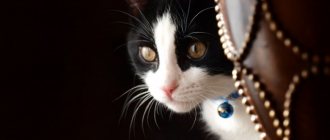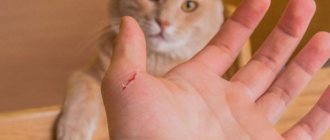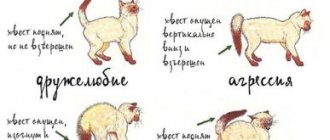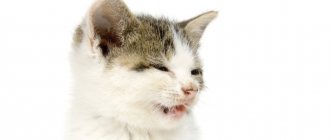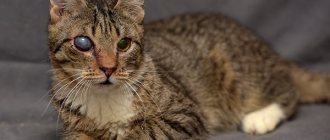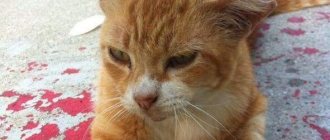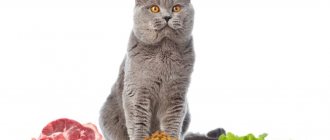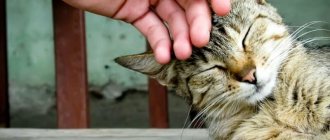Causes
It should be noted right away: in most ophthalmological diseases of cats and humans, the pathogens are the same. Therefore, after touching your pet's eyes, you should wash your hands with special care.
Squinting indicates that the animal is experiencing pain or discomfort, which is caused by the following reasons:
- infectious diseases;
- injuries;
- inflammation of the third eyelid;
- glaucoma.
Clinical symptoms, diagnostic methods, treatment and prevention vary depending on the cause. Therefore, each disease is described in a separate section.
The cat does not look straight, but squints
We hope that at this moment you are not stopping her from stealing warm cutlets from the table. Just like in humans, in animals such fleeting glances to the side mean unnoticed peeping. If an animal casts quick, short sidelong glances at you, it wants to see your reaction, to understand what you are doing, how you are reacting to its behavior.
If a cat looks askance at you while playing, and its pupils are large, then your animal is showing its playfulness in this way, expecting reciprocal play actions from you. A sidelong glance is a common curiosity, unless of course you offended your pet the day before - after all, perhaps he is just remembering his offense while looking at you.
Contagious diseases
Damage to one eye is typical for the following infectious diseases:
- herpes;
- chlamydia;
- demodicosis;
Herpes
Blepharospasm
A viral disease better known as rhinotracheitis. An acute course is typical for unvaccinated kittens from two to three months. Chronic disease occurs in adult animals during periods of weakened immunity. At the initial stage, blepharitis develops, which is characterized by inflammation of the eyelids. They stick together and blepharospasm develops.
Subsequently, the second organ of vision is also affected. A characteristic sign of rhinotracheitis is ulcers on the cornea of the eye. Self-medication is dangerous because it can cause loss of one or both eyes, bronchopneumonia, constipation, and damage to internal organs. Treatment is prescribed by a veterinarian. To prevent rhinotracheitis, kittens and sexual partners are vaccinated before mating.
Chlamydia
The bacterial infection primarily affects kittens from 1 to 3 months. At this time, death is possible. With chlamydia, one eye first becomes inflamed, then the second is affected.
Be sure to read:
Crusts on cats' ears: advice from a veterinarian, should you be afraid of them?
With chlamydia, one eye is affected first.
Treatment is prescribed by a veterinarian. If ophthalmic ointments or drops are used, two eyes should be treated, even though one of them looks healthy. Prevention consists of proper feeding, satisfactory living conditions and vaccination with a polyvalent drug against chlamydia and other dangerous diseases of cats.
Demodicosis
Demodicosis glasses
The pathological process is caused by the activation of the subcutaneous mite due to a weakening of the immune defense. With asymmetrical lesions, demodectic glasses are formed around one of the eyes. Soreness causes the pet to squint one eye.
Treatment consists of treating the affected surface with external insecticidal and acaricidal agents. If the pathological process goes far, inflammation occurs.
As the affected area heals, it scars and squinting becomes a lifelong cosmetic defect. Prevention consists of proper feeding, as well as applying insecto-acaricidal drops Spot on to the healthy, intact skin of the withers, which protect the pet from fleas, helminths, cutaneous and subcutaneous ticks.
Why does a cat squint when looking at its owner?
Contents hide
Why does a cat squint when looking at its owner?
Today we bring to your attention a new article from the pen of our longtime friend Ami Shojai. And she, as you know, knows everything about cats! Therefore, every article by this author is a celebration on the street for lovers of these animals. The topic of conversation is interesting: why does a cat sometimes squint its eyes? What does it mean? We look forward to clarification!
Why does the cat do this? Let's start with the fact that it is an integral part of the natural behavior of cats, due to the structural features of the eyelid. Experienced cat owners will confirm: their pets can actually speak with their eyes. One close look at a cat, made by an experienced, understanding owner, can tell a lot. And for our less experienced readers, let us note: with their gaze, cats convey their very different emotions. These emotions can be addressed to both people and other cats.
Here she looks with a long, “unblinking” gaze. This is a gesture of intimidation used by strong cats that occupy leading positions: having met such a gaze, the weaker animal must step aside or leave altogether.
Aggressive cats with a highly developed territorial instinct have their own “special” look, with which they suspiciously inspect the “entrusted” territories. Other cats are well aware of the consequences that could occur if they accidentally end up there. More valuable to yourself! You have to put your tail between your legs and leave.
So you met a cute pussy on the street and decided to make friends with her. Many people make the “classic” mistake of starting to stare directly at the animal. It perceives it as an act of aggression, instantly gets scared and runs away. Next time you will introduce yourself more carefully!
Cats also cannot be blamed for their lack of acting talent; if necessary, they masterfully hide their emotions. As a rule, these emotions are called “fear” and “fright.” What is the best way to hide a strong fear? That's right, squint your eyes and pretend that you are quite ready for external challenges. True, the cat's squint also has a purely practical purpose - by squinting, the cat tries to protect its eyes from the claws of a potential enemy.
Are there positive signals in a cat's squint? Of course have! You know how a cat, being in a complacent mood, living in comfort and bliss, usually looks at the world - with eyes wide open. Looking at the owner with a “wide look,” the cat gives a message: everything is fine with me, I’m ready to play and exchange pleasantries. Little kittens who have not yet encountered the vicissitudes of this life often look with such eyes.
If your cat has a gentle, friendly nature, then don't worry if you catch her slightly squinted gaze. It means the same thing - the kind and friendly intentions of your pet towards you. A kind of “cat kiss”! Often similar glances are exchanged between cats living in the same house. In this bizarre way, one of the animals shows that it is peaceful and is ready, if necessary, to compromise and smooth out any rough edges in the relationship.
By the way, you will be surprised, but experts and scientists have unraveled the true intentions of the tailed creatures thanks to chance. The beginning was made by the famous cat behaviorist Anitra Frazier. In one of her books, she describes how, while on duty at the shelter, she found all her charges (that’s 45 cats, just for a moment) in a state of shock and wild horror - terrible thunder rumbled in the street and lightning flashed. Anitra decided to try to help the animals, and completely instinctively she used this tactic - she began to blink slowly, then squint her eyes. Soon peace, quiet and quiet reigned in the shelter.
You can test the validity of this theory on your pet. If you catch him acting up or scared, try blinking slightly and then squinting your eyes. However, it is not even necessary to bring things to the point of stress or fear: during the moment of affection, just communicate in this way. And whether you succeeded or not, write to our editor - we will be waiting for you.
Original publication: Why Cats Blink Their Eyes At You. Author: Amy Shojai Source and photo:
Injuries
Unilateral damage most often occurs in a fight, and also occurs when a cat is stung by a bee. One side swells and the eye closes. A pet injures its eye while chasing prey, or when a splinter gets into the soft tissue or a small solid particle gets into it. Ophthalmic drops are used for treatment.
If the use of an external remedy does not lead to the desired results. Seek veterinary help.
Treatment of abnormalities
Self-therapy for this pathology is excluded. You cannot reset a prolapsed membrane at home.
The pet will have to be treated in a hospital setting. The veterinarian decides which method to choose (passive or operative).
Drug treatment
The course of therapy is selected based on the cause that provoked the pathology.
Usually prescribed:
- drugs for healing an injured eye;
- antibacterial drops and ointments;
- antihistamines (for allergic conjunctivitis);
- hygiene lotions.
At the same time, they treat internal diseases and fight parasites.
Weakened animals are prescribed vitamin preparations. In some cases, hormonal therapy is resorted to.
Surgical intervention
Surgery is required in rare cases when a cat begins to have vision problems due to a protruding eyelid. This is usually observed during the formation of an adenoma.
Eversion is also surgically eliminated (cartilage damage cannot be treated with conventional medications).
Do folk remedies help?
Homemade recipes will not help with eyelid loss. But you can use herbal decoctions to wash the eyes if the cause of the formation is associated with inflammation of the conjunctiva.
Inflammation of the third eyelid
The nictitating membrane in an active cat is invisible. The transparent membrane protects the eye sphere from dust particles and debris. Due to the inflammatory process, the membrane hypertrophies and no longer fits under the eyelids.
Most often, unilateral inflammation is observed due to the following reasons:
- infectious diseases;
- allergic reactions;
- injuries;
- internal non-communicable diseases;
- congenital predisposition.
Most often, Persians, Britons, as well as mixed breeds and cats of related breeds get sick. Treatment is surgery. To prevent inflammation of the eyelid, you should purchase a pet from trusted breeders and not engage in spontaneous selection.
Be sure to read:
What to do if a cat has a lump on its ear?
Causes of squinting eyes in cats
The cat's eye is an incredibly sensitive organ, so quite often it can be susceptible to inflammatory processes and the development of various pathologies. Many diseases can manifest themselves in this way when cats squint their eyes.
Let's take a closer look at the reasons for this phenomenon.:
- The presence of conjunctivitis is an inflammatory lesion of the mucous membrane of the eye. The disease is accompanied by swelling of the eyelids, mucous and purulent discharge. The affected eye becomes red and itchy, and a bluish or white cloudiness may also appear on it. To treat pathology, special eye drops are used, and rinsing procedures are also carried out. In later stages of the disease, antibiotic injections may be prescribed.
- Corneal erosion is damage to the cornea of the eye. An equally common reason why a cat squints one eye. The causes of the development of the disease are viral infections, injuries, burns, and glaucoma. Untimely treatment leads to the formation of a serious pathology - a corneal ulcer.
- Mechanical injuries to the cornea , which are always accompanied by severe pain and, as a result, the cat begins to squint its eyes. The insidiousness of such injuries lies in the penetration of pathogenic microorganisms into the depths of the tissues of the eye, where they further multiply. You should be especially careful about eye injuries caused by cat claws, since a large number of dangerous bacteria and worm eggs accumulate under them.
- An increase in eye pressure , which occurs due to age-related changes and the old age of the animal, is also a possible reason that the cat squints the visual organ. Due to the lack of proper treatment, this condition can predispose the cat to the development of one-sided blindness.
- Allergic reactions to flowers and plants , dust and household chemicals often cause a kitten to squint its eyes. A veterinarian will help identify the causative agent of the allergy and prescribe appropriate medications.
Glaucoma
Glaucoma
Elderly pets suffer from numerous chronic diseases, against the background of which eye pathologies develop. With glaucoma, intraocular pressure increases. The affected organ becomes sensitive to the slightest irritation. The cat develops photophobia: bright light causes the affected eye to squint.
Congenital glaucoma is observed in Persian, Siamese and British kittens. The development of the pathological process can be slowed down if the underlying disease is treated. Full recovery is impossible. Conservative treatment is aimed at relieving pain. If pathological signs increase, surgery is performed. Most often, the damaged organ is removed.
Glaucoma in a kitten
Prevention of congenital diseases involves excluding parents of sick kittens from breeding. Thoroughbred young animals should be purchased from trusted breeders who value their reputation.
Chronic diseases of older animals are prevented by compliance with housing and feeding standards, timely deworming and treatment against external parasites.
Third eyelid
This disease, in which a cat's eyes are half closed with a film, is conventionally called the third eyelid. The film that appears on the outside of the eyeball can cover most of its surface. In addition to external signs, the third eyelid also affects the behavior of the cat.
Film on eyes
The pet owner may notice previously uncharacteristic habits:
- Constant blinking and squinting of the eye due to increasing discomfort.
- The cat hides from bright lighting, especially artificial light.
- The pet rubs its muzzle with its paws, most often the eye area.
Additional external signs include increased tearing of the eyes, suppuration and swelling of the mucous membrane, as well as a rapid decline in the pet’s visual acuity. Inaction in the event of such a phenomenon is very dangerous and can lead to complete blindness of the cat.
For old cats, such a symptom is not evidence of pathological processes. However, you cannot do without the help of a veterinarian.
